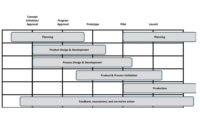The automotive industry describes its approach to product development and manufacturing in the advanced product quality planning (APQP) process. Within this structure are a collection of activities and artifacts that are collectively called the production part approval process (PPAP). The PPAP provides evidence of the actions taken by an automotive supplier to design and produce a quality product. Parts shipped to an OEM require a PPAP submission and customer sign off. Without them, the supplier’s parts cannot enter the OEM’s assembly plant.
APQP outlines the product development process from idea through to manufacturing. So, too, does the PPAP. It consists of the following 18 items: design records; customer engineering approval; process flow diagram; control plan; dimensional results; initial process studies; appearance approval report; golden, or master, sample parts; customer requirements; engineering change documents; design failure mode effects analysis (DFMEA); process failure mode effects analysis (PFMEA); measurement systems analysis (MSA); material and performance test results; lab certification documentation; sample production parts; checking aids; and part submission warrant.
Some of these items are the responsibility of the product design team. They range from the initial documentation of the product requirements to the changes that were made during product development. They also include the formal and specialized form of design review known as design failure mode effects analysis, which is used to drive design improvements throughout development.
Other items are the responsibility of the manufacturing team. These range from the design of the manufacturing line to the critique of that line (the PFMEA and MSA). It also includes a trial production run, from which the team learns and makes adjustments to the process, and the run at rate, which will be reviewed by the customer’s quality assurance team. A batch of parts from the latter will be used for initial sample approval (ISA) by the customer.
The ISA parts will be accompanied by a part submission warrant, whether the customer is present during the run at rate or the parts are shipped to the customer. The parts will go through dimensional checks and other tests. The warrant identifies the part and is attached to the product. The warrant makes it possible to trace a specific product to specific materials, design and manufacturing processes.
There is a difference in risk between a product change or update and an entirely new product introduction. As a result, the OEM and the supplier can tailor the PPAP process based on the nature of the effort. A level 1 PPAP—the simplest—requires only a new part submission warrant. A level 5 PPAP is used for new product development or significant changes to the product and the manufacturing line. This level will require a new run at rate and ISA.
Any effective approach to product development and manufacturing must be able to track the steps and provide mechanisms that link a specific version of the product to a specific incarnation of the design and manufacturing process that created it. The PPAP process does that. This continuity provides a baseline for continuous improvement and a point for problem resolution if a latent defect is found. As a result, both supplier and OEM can have confidence in the chain of events that brought the product to that point.



